
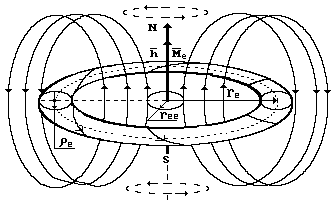
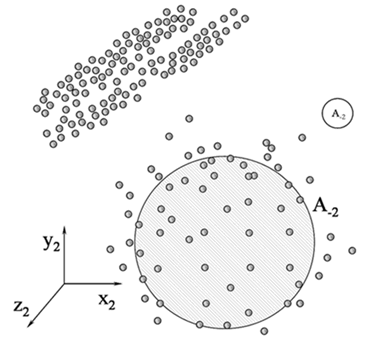
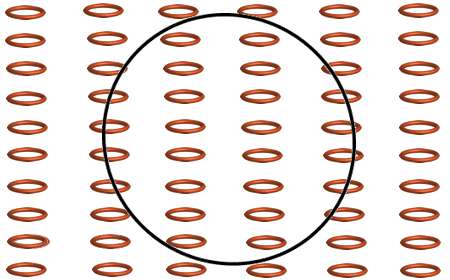
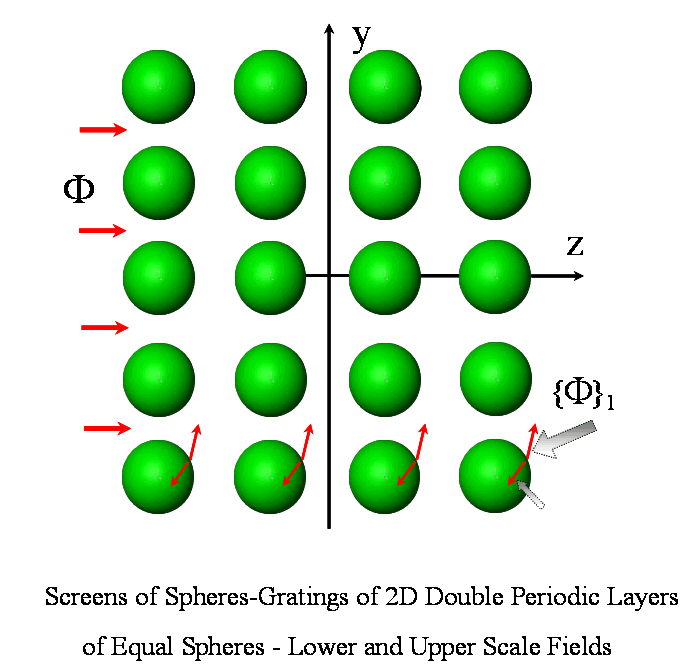
-468x280.gif)
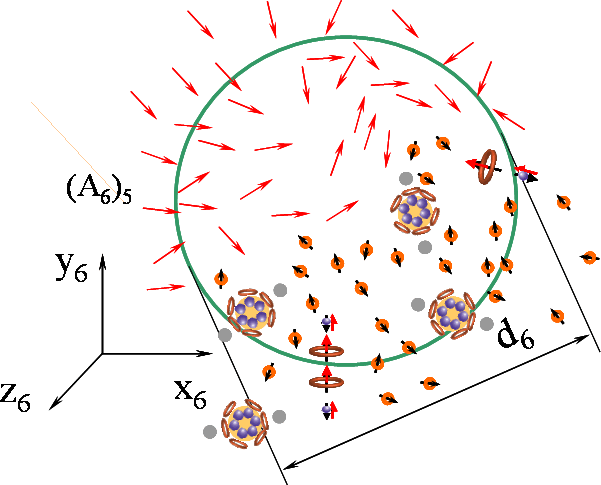
The Annals of Frontier and Exploratory Science
Vladi S. Travkin
Hierarchical Scaled Physics and Technologies (HSPT), Rheinbach, Germany, Denver, CO, USA
Abstract - Extended for Heterogeneous Particle Physics - (HtPP)
The first part of this manuscript is almost the same as for the chapter "Scaled Modeling of Interaction and Interscale Hidden in COHP Forces and Effects in the Sub-Atomic Particle Arrays (Clouds). Physics 2" above - while will be modified further the both parts (in 4 sciences they are actually placed) according to their needs for presentation of the Identical Particle Arrays (Almost Identical Particle Arrays) 3P HSP modeling short narrative.
We had said on many occasions that we considering that the referencing to the outdated, the fantastic funny "ravery" of COH physics system regarding the Heterogeneous Scaled Media and Processes (HSMP) in the universe is wrong. The physics COH is wrong and misleading students on these HSMP issues- no matter how close is the publication date.
Students, professionals in the workplace - please, read and try to apprehend the arguments in our manuscripts, chapters, papers on Electrodynamics, Particle Physics, Nuclear physics and other sciences with, at least, introductory facts and developments, comparisons of COHP and HSP results of 50 years of developments.
This 2017 year is the 50-th Anniversary of WSAM theorem publications - 4 working groups published it in different appearances in 1967.
In this group of a few papers, manuscripts placed in Heterogeneous Classical Mechanics science and now for Heterogeneous Particle Physics - (HtPP) in HSP (Hierarchical Scaled Physics), about the "so-called" Many-Body and n-body problems (MBP) [1-13] as they have being stated through the ~3-3.5 hundred years in COH physics as the Point-mass One-phase mathematics mostly based on statements we would address more directly and with more straight hits on these impaired parts of COHP in comparison to HSP with a discrepancy level that senior years university students, grad students can apprehend.





-468x280.gif)

Various kinds of Sub-atomic and Continuum Media singular and Arrays (Clouds) of Particles, Atoms, Molecules that have usually the interactions of different kinds. In COHP the Interaction of particles and bodies either are taken falsefully via mathematical none-physical One-scale methods, or at Sub-atomic scales just prohibited as the none-existing and taken via Superposition also the One-scale "magnificent" simplification "methods" of the first half of XX century. And up to nowadays.
Let's make a direct comparison of the very established in COHP MBP literature the mathematical COHP MBP statement and for the same physical MB problem the formulation of the HSP MB problem governing equations.
The Many-Body Problem (MBP) for the atomic, sub-atomic particles in COHP is the fantastic funny "ravery" about how to adjust COHP Point-Mass-Charge-Spin (PMCS) imaginary particles theories about dynamics of Imaginery "particles" with the some experimental (often heavily adjusted also) results [13].
On the other side the much older COHP attempts for the MBP as for the n-body gravitational mostly interaction of mass-points, see in Wiki, for example, [12] and other astronomical literature is the ficticious also pure mathematical kind of problem about interaction of N mass-points.
The COHP mathematical formulation and the set of governing equations for the just dynamics of a cloud of N interacting via gravitation or/and electromagnetic fields particles (bodies) writes in as a set of N momentum equations, for example, for only gravitation interaction

While, and this is not accidental that in no one textbook there is any explanation exists that the summation of only the pair-wise interactions over the only right hand side of the equations is at least the two-fold irregularity involved in this way into equations formulation.
And Newton knew about this. He just did not forecast this kind of so wide, so simplified interpretations of his 2-nd law written actually for a one particle - Local dependence. One more incorrectness in writing equations (1ort) for a system of continual particles is that taken into account only the pair-wise force interactions?! Others, those of the higher order of interaction between particles/bodies are not Known and Exist in COHP openly? Non-local interactions were taboo and not known in XVIII - XX (first half).
Another great physical first of all imbalance is that in this equation its left and right parts are not corresponding one to another physically. The left part is the Local effect mathematical expression - while the right hand side is the rood (approximate) one-phase Non-local interaction mathematical derivation.
And it is not so innocent mishap as many can imagine. We wrote about this imbalance in some other extended articles, manuscripts, chapters [1-2,6-9,14-32]. More on that - the Local One-phase formulation of the Non-local Two-phase Two-scale problem of Gravidynamics of a few or Many bodies/particles simply is inadequate physical and mathematical formulation and statement of gravidynamics MBPs.
The verbal only explanation of this is that the One-phase Local MBP formulations are underdetermined, lack of needed formulations.
One more great imbalance in COHP MBP formulation and statements is that all COHP MBPs are the One-phase One-scale physical and mathematical statements and understanding of this kind of interactive dynamics of particles/bodies. In the proper stated MBP in HSP the locality, scaling, and Polyphase presense issues are taken care of [1-11,14].
If we write the momentum dynamics equation for a continuum scale size particle moving in an air, for example, this would be as of the following COHP not often used model

where

 is
the dynamic viscosity of the continuum model fluid (air) around the particle
and where the vector
is
the dynamic viscosity of the continuum model fluid (air) around the particle
and where the vector

 is
the inward to particle from air directed differential area
is
the inward to particle from air directed differential area

 =
=

 and where the second term in the r.h.s. is generally incorrectly calculated
one as long as in COHP physicists do a hundred years the wrong model for the
electromagnetic interaction force - the Lorentz force. The one-side-one-charge
force [33-35].
and where the second term in the r.h.s. is generally incorrectly calculated
one as long as in COHP physicists do a hundred years the wrong model for the
electromagnetic interaction force - the Lorentz force. The one-side-one-charge
force [33-35].
And we know why COHP physicists do this simplified one charge incorrect conjecture? That is because in COHP physicists don't know - How to make the Collective - not pair-wise, but Interaction for Many-Body and similar Problems? Which is the Electromagnetic and Spinning Collective Interaction within a Cloud of particles or a Piece of material. Not just a Linear Superposition Interaction that like "justifies" Summation of Pair-wise Two-particle Force Interaction (SPTFI) [14-19].
Then it needs to be confirmed that the point-mass idealization of XVII-XX-XXI centuries in equation (1) is made here for analysis taking to be closer and following the much established in COH physics of Point-Mass-Charge-Spin (PMCS) interpretation of natural physics processes at sub-atomic scales.
In the proper (full) HSP MB statements the left and right parts of these problem Governing Equations (GE) are taken as for distributed spatial matters [1-6,9,11,15-19].
The same size continuum particle moving in the aether only while considering the scale almost the same or the same as above has the dynamics equation

where

 is
the dynamic coefficient (similar to dynamic viscosity) of the continuum model
aether around the particle and where the vector
is
the dynamic coefficient (similar to dynamic viscosity) of the continuum model
aether around the particle and where the vector

 is
the inward to particle from aether directed differential area
is
the inward to particle from aether directed differential area

 =
=

 ;
and where the r.h.s. first term assumes the quite different disclosure and
mathematics - if we do consider the particle (pi) as the solid body at any
scale, including and sub-atomic scales.
;
and where the r.h.s. first term assumes the quite different disclosure and
mathematics - if we do consider the particle (pi) as the solid body at any
scale, including and sub-atomic scales.
Where the "internal" interface combined surface

 is much larger then the Continuum only scale surface
is much larger then the Continuum only scale surface

 ,
because the former includes into its value and internal for particle
(continuous) interface "Surface"
,
because the former includes into its value and internal for particle
(continuous) interface "Surface"

 of all particles atoms within the REV
of all particles atoms within the REV

At the same method - if we consider the flow of
aether's phase

 inside of each condensed particle
(
inside of each condensed particle
(

 )
as well as outside of the particle's condensed matter volume - we need to
take into account the difference of aether flow inside and outside of a
separate particle.
)
as well as outside of the particle's condensed matter volume - we need to
take into account the difference of aether flow inside and outside of a
separate particle.
When using the special technique considering the each atom as a special particle model [1-2,9,11,15-19,29-30] for each atom (i-th) we can write this approximate equation of dynamics

where

 and
and

 ,
,

 - subvolume of aether in the REV occupied or filled with the gaseous substance
of aether, and
- subvolume of aether in the REV occupied or filled with the gaseous substance
of aether, and

 - is the subvolume of a particle body (condensed state) in the REV.
- is the subvolume of a particle body (condensed state) in the REV.
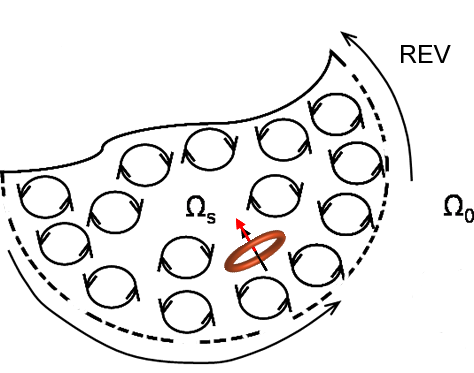
Figure: Schematic of Continuum Media (CM) (or Condensed state) particle with rotation and some SAP spinning inside of that particle. The Boundary "surface" of this particle is not the smooth surface, but tight surface of "boundary" atoms electrons and their potentials - if we imagine this "surface" at the sub-atomic scale. Free area ourside of the particle is filled with the aether of course.
Also the term with

 - is the Collective Interaction of this particle-atom (the additional
interactive EM force with the function of the Lorentz force, but not the
Lorentz force), with all other in the substantially valuable and performing
the role
- is the Collective Interaction of this particle-atom (the additional
interactive EM force with the function of the Lorentz force, but not the
Lorentz force), with all other in the substantially valuable and performing
the role

 in the 2nd Newton like law for atoms.
in the 2nd Newton like law for atoms.
Why this equation of high regard HSP theory is still may be called
approximate on the Lower scale single particle-atom dynamics formulation?
Just because the force of interaction due to electromagnetic interaction

 is still defined here in a vague mode.
is still defined here in a vague mode.
To make the EM interaction strictly in accordance to HSP we need to involve physics and modeling tools for Electrodynamics 2 [24-26] and of Spinning physics [20-22].
Now - the dynamics equations (simplified still) for atoms in the continual particles and in the outside aether area or outside Two- or more phase volume, including the aether, will be as the following

For each atom at the

 physical boundary the first r.h.s. term won't be included. While for each
atom outside of
physical boundary the first r.h.s. term won't be included. While for each
atom outside of

 and within the
and within the

 vice sersa the second r.h.s. term will vanish.
vice sersa the second r.h.s. term will vanish.
Now - when we transform the movements of the particle's
atoms and the phase

 or
or

 of the aether - we would like to compare and explain the two equations
(2) for the scale of a one Continuous (solid phase) particle and the Upper
scale dynamics equation (that we developed and published in many papers
[1-5,9,15-19,24-26,28-30]) in the REV.
of the aether - we would like to compare and explain the two equations
(2) for the scale of a one Continuous (solid phase) particle and the Upper
scale dynamics equation (that we developed and published in many papers
[1-5,9,15-19,24-26,28-30]) in the REV.
That means the usual known problem of comparing and determining the connection of the equation (2) to this one


and the whole averaged r.h.s. of the electron dynamics equation in the aether


which was written for a cloud of electrons with the interactive electromagnetic polyfields from the moving other electrons.
Following this equation we write down the Upper scale momentum equations for a Solid State (center of mass - the full dynamics set of equations for SS or sub-atomic scale particles imbraces more governing equations - which we write out in other publications) particle


and the whole averaged r.h.s. of the equation


and for atomic scale particles - atoms


with the whole averaged r.h.s. of the equation


which should be compared to equations (1,2) for analysis of the question - What kind of additional forces act (have an impact) upon the separate ( or a single particle - if the problem can be confined to the dynamics of "identical" particles in the 1D moving (flow) of a cloud) particle in the cloud of particles.
Intermediate Summary
The analysis given here only for the Two-scale and only the momemtum dynamics of particles Governing Equations (GE). The other sets of GE, the equations for both phases and for electrodynamics and aetherodynamics should be added to complete this Two-scale Two-phase particles dynamics model.
This theory, manuscripts, papers are the content and sense of what W.Heisenberg thought, dreamed, and wrote about as of "the real particles dynamics" as the genuine narrative of dynamics of Sub-Atomic particles.
Students - are you aware of that because of the absence, none of tools, theories in COH physics in ~1910-20s - there is NO Sub-Atomic Particles (SAP) dynamics in COHP? Because the meaning of SAP as of the particles - the pretty small volumetric objects had been prohibited in COHP since ~1910-20s.
You don't know about this prohibition because professors prohibited to tell you on this! Because if Particles Dynamics Real (PDR) exists - then there is no need to keep and talk about faked QM and QED? Meaning they were created not specifically to fake students and public - but because there were no TOOLS, theories in that time 1910-1920 to treat SAP as physical objects. That is because and Einstein in passing, with hidden sense words - not openly, and W.Heisenberg spoke - that there were no opportunity to theorize about the SAP - but only after acceptance of QM.
E.Madelung's equations of quantum hydrodynamics were not finally approved - yes, they also were lacking of important features for modeling of SAP [1,2], but still they were better off than the QM. Simple - that QM was completely mathematical more straightforward, easier, directly applied and incorrect fundamentally [27] - but Madelung's quantum hydrodynamics equations were even not solvable in a good sense at that time 1920-30s - there were no computers, No Heterogeneous Media theories in physics and even in mathematics, no computational mathematics - that kind of mathematics (not the calculation of ordinary differential or algebraic equations) was created later on after the WWII specifically for massive calculations of partial differential equations that nobody could think to calculate in 1910-1930s, no simulation methods, etc. then.
Equations (5,6) when written for a single "identical" particle - atom or a particle in a beam of "identical" particles in accelerator, for example, can be characterized with the following two equations - one is for an atom in the aether and another is for atom in a moving solid or fluid state or just of condensed matter (with its properties at the continuum scales) continual particles.
The first equation for an atom in the aether when

 is (still
is (still

 is
here the center of mass velocity )
is
here the center of mass velocity )


and the whole averaged r.h.s. of the equation


where



 is the surface of equipotential of the atom of a special kind (averaged)
electromagnetic fields,
is the surface of equipotential of the atom of a special kind (averaged)
electromagnetic fields,

 and where
and where



 is
nullified due to specifics of initial problem's conditions - particles (atoms)
are equal and have the equal dynamics properties while acting far enough one
from another in space.
is
nullified due to specifics of initial problem's conditions - particles (atoms)
are equal and have the equal dynamics properties while acting far enough one
from another in space.
This equation (7) should be compared to the Lower scale equation (2)
while with the achievable result of calculation the l.h.s. terms in (7) - the
second and the fourth (last) term. As well as the last term in the r.h.s. -
which is the EM interaction term

 [15-19].
[15-19].
Now let's derive the dynamics equation of atom movement inside of the Continuum particle (body) which itself in turn is moving in the pure aether nevertheless. The correct, geometrically contained cubic structural morphology is set-up at the beginning - so we can persue the statement for identical atoms(particles) as this one


and the whole averaged r.h.s. of the equation


Here, in this equation we cannot permit ourselves to drop the last 5th term in the l.h.s. of the equation (8) because of the velocity of even binded atoms (particles) in a Solid State (SS) particle still can be different in various spots of the particle. As well as generally in the condensed particles
Meanwhile, atoms inside of a SS body can be moving with an equal speed - then this term can be also nullified.
We solved firstly in HSP - means in general physics many MBP formulated correctly as the Two-scale Two-phase (2P2S), at least, problems in the 1980-2000 [36-38,39-43] with some of them solved even analytically [36], other. Here in this analysis we continue the 2P2S series of formulation for Globular morphologies of media - particulate media.
Mathematical formulation (statements) for certain condition particulate systems will allow simplification for GE formulation and consecutively for solutions.
Some classes of MBP tasks can be formulated for clarification of physical paramenters, a search or study for external parameters setup, for the Reverse Physics Top-Down (RPTD) formulation and study for the needed conditions or the effect sources Down-Scale, etc., etc.
Most of these problems as the RPTD can not be formulated in usual COHP mode formulation of problems:
a) because there is no HSP accepted by the high ranks of physical establishment world-wide;
b) because COH physics itself has no Scaled formulated correctly problem TD statements - all these COHP "averaging" and coefficient search are the wrong tools for formulation of TD physics;
c) because the tools in COHP is primarely the mathematical wrong formulation of Two- or more phase problems;
d) because the method of MD is itself mathematically wrong [44-45] and doesn't fit for the TD simulations, etc. etc.
Following equation (7) the dynamics equation for a single
atom moving interacting with other neighboring atoms and aether at a constant
speed is
(


 )
)


and the whole averaged r.h.s. of the momentum equation


where the three other terms from the l.h.s. of (7) have being disappeared due to the initial set up of the task.
The 3 surficial terms and nondifferential integro-algebraic equation's type (9) give chances to use this equation easier than (7,8) for numerous purposes including experimental. Comparing this nonlinear equation (9) with equation (3)

we understand that equation (3) with the premise of the Straight Equal Speed Movement of Interacting particles or atoms means that the 3rd Newton law is in action as in the following notation

while without the two other surficial effects (phenomena) at the left side of equation (9).
Where the first left side equation (9) term is generally "the force induced by the moving particles collective bounding (interface) surface" effect [1-2,9,14,24-25]. The second l.h.s. term in (9) is "the force induced by the penetration of aether (transition) through the particles collective interface surface" [1-2,15-19]. Both effects for this class of particles - "single atom moving interacting," relate and effect the single particle interface surfaces.
Then one would ask a question: So, why is that difference between (9) and (10)?
The difference is explainable due to the few reasons - the main of those is that in consideration of the Scaled Dynamics Process and Modeling equations generation we need to use the Two Scale modeling at least. This is turn, mathematically controls the appearance of a few new terms - effects in the Governing Equations for the problem.
There are lengthy explanations of these mathematical (and physical) causes for appearance of the different equations for the same practically phenomena at just different scales all owe these chapters-sciences of Physics 2 in this website [1-2,4-6,9,15-19] and many other researchers publications [46-52]. Particularly regarding Particle Physics, two-phase movable media in [46-48,53-58].
More on that - if not to use the Scaled Hierarchical formulation and Modeling - then this means the lost of physical phenomena to account for and model, simulate, and study them. Which actually and happening throughout the last ~60 years when science understood that the Heterogeneous meda, physics is the central part, body of all physics. Scientists just do whatever they have been taught in their universities - COH physics and technologies [1-2,24-29,53-58] .
Meanwhile, equation (9) is a good candidate for a role of interstellar energetic particles dynamics equation.
For the same problem of movement of equal particles (continuum ones) cloud in the gaseous or fluid media with a constant speed we would derive the GE as this one for a single particle




Again this equation can be compared with the COHP (1ort) and with half-COHP "no scale" equations for dynamics of one atomic or continuum particle (1,2).
Also, we would like to remind - that the solutions of the half-COHP and HSP formulated mathematical problems (1) - (11) correctly demand the 2-scale formulation and use of Hierarchical mathematics. It's not only, for example, the simplified equations (9,11) or even equation (10).
The GE set includes and hydrodynamics and electrodynamics of the
aether sets of equations, the 2-phase (at least) rotation (or spinning) in 3DD
of particle itself equations. That means the use of the first phase of the
aether - of the sub-phase

 of the aether as of the continuum fluid like medium
[59-62,14-19,20-22,24-26,30,53-57].
of the aether as of the continuum fluid like medium
[59-62,14-19,20-22,24-26,30,53-57].
So, the MB Problems even of this simplified One speed Equal particles class mathematically are pretty cumbersome, see most of the developed mathematical governing equations in [1-6,10,14-19,30,39,42-45,50,52-55], while their solutions demand the great social and computing resources [3-6,9-10,14-19,23-26,29-32,36-38,39-43].
The full sets of CM and SAP arrrays dynamics with exchange simulation GE exceed 30+ equations usually. The only available modeling GE in all "phases" and for accounted above physical phenomena at present exist in HSP.
Continuing to "seek" the MBP solutions and simulation in COH physics and related COH mathematics is just the pure waste of resources in all branches of science and technologies. Technologies especially won't bare the cost and for - What the reason? [1-5,9-10,14-19, etc.]. Meanwhile, the obsolete and often wrong practices and techniques used in COHP system particulate media theories and simulation methods should be driven out of universities at least since the 80s.
Conclusions
The consequences of the One-scale One-phase COHP (Conventional One-phase Orthodox Homogeneous Physics) theories and modeling for many kinds of particulate media, not only of Continuum or Sub-atomic scales, compared and partly analyzed with the Two-scale Polyphase HSP (Hierarchical Scaled Physics) theories and modeling for mostly Sub-atomic Particle (SAP) arrays (clouds) in dynamics.
----------------------------------------------------------------------------------------------------------------------
The analysis given here only for the Two-scale and only the
momemtum dynamics of particles Governing Equations (GE). The other sets of GE,
the equations for both phases and for electrodynamics and aetherodynamics
should be added to complete this Two-scale Two-phase particles dynamics model.
This theory, manuscripts, papers are the content and sense of what W.Heisenberg thought, dreamed, and wrote about as of "the real particles dynamics" as the genuine narrative of dynamics of Sub-Atomic particles.
Students - are you aware of that because of the absence, none of tools, theories in COH physics in ~1910-20s - there is NO Sub-Atomic Particles (SAP) dynamics in COHP? Because the meaning of SAP as of the particles - the pretty small volumetric objects had been prohibited in COHP since ~1910-20s.
You don't know about this prohibition because professors prohibited to tell you on this! Because if Particles Dynamics Real (PDR) exists - then there is no need to keep and talk about faked QM and QED? Meaning they were created not specifically to fake students and public - but because there were no TOOLS, theories in that time 1910-1920 to treat SAP as physical objects. That is because and Einstein in passing, with hidden sense words - not openly, and W.Heisenberg spoke - that there were no opportunity to theorize about the SAP - but only after acceptance of QM.
E.Madelung's equations of quantum hydrodynamics were not finally approved - yes, they also were lacking of important features for modeling of SAP [1,2], but still they were better off than the QM. Simple - that QM was completely mathematical more straightforward, easier, directly applied and incorrect fundamentally [27] - but Madelung's quantum hydrodynamics equations were even not solvable in a good sense at that time 1920-30s - there were no computers, No Heterogeneous Media theories in physics and even in mathematics, no computational mathematics - that kind of mathematics (not the calculation of ordinary differential or algebraic equations) was created later on after the WWII specifically for massive calculations of partial differential equations that nobody could think to calculate in 1910-1930s, no simulation methods, etc. then.
Continuing to "seek" the MBP solutions and simulation in COH physics and related COH mathematics is just the pure waste of resources in all branches of science and technologies. Technologies especially won't bare the cost and for - What the reason? [1-5,9-10,14-19, etc.]. Meanwhile, the obsolete and often wrong practices and techniques used in COHP system particulate media theories and simulation methods should be driven out of universities at least since the 80s.
----------------------------------------------------------------------------------------------------------
Key words: Multiscale; Polyscale; Polyscale modeling; Heterogeneous media; WSAM theorem; Averaging theories; Polyscale physics; Two-phase Two-scale dynamics; Homogeneous Electrodynamics; Heterogeneous electrodynamics; Sub-Atomic modeling; Particles modeling; Elementary particles dynamics; Collective interaction; HSP-VAT; Scaleportation; Many Body Problems (MBP).
References:
1. Travkin, V.S., "What Classical Mechanics of XVIII Provided in XX Has Done Wrong to the Base of Mechanical Science Including the Classical Mechanics of Continuum Particles and Conventional Orthodox One-scale Homogeneous Particle Physics", http://travkin-hspt.com/rottors/classmechwrong/classmechwrong.htm, (2014)
2. Travkin, V.S.,"The Major Forces Have Been Missing From Governing Equations for Dynamics of Sub-atomic and Continuum Particles, Bodies in XVIII - XX ", http://travkin-hspt.com/rottors/forcemissing/forcemissing.htm, (2014)
3. Travkin, V.S., Physics of Many-body Continuum Media Problems. Not Only Mathematics. Physics 2, http://travkin-hspt.com/elastic2/manybody/manybody.htm, (2016)
4. Travkin, V.S., Physics of Many-body Particulate Media Problems. Not Only Mathematics. Physics 2, http://travkin-hspt.com/parphys2/manypartibody/manypartibody.htm, (2016)
5. Travkin, V.S., Physics of Many-body Atomic Media Problems. Not Only Mathematics. Physics 2, http://travkin-hspt.com/atom2/manyatombody/manyatombody.htm, (2016)
6. Travkin, V.S., "Wrong and Inadequate None-physical "Solutions" of Many-body (and n-body) Problems in COHP Holding Back Contemporary Science and Mankind in General. Physics 2," http://travkin-hspt.com/classmechht/mbphypomech/mbphypomech.htm, (2016)
7. Travkin, V.S., "Scaled Modeling of Interaction and Interscale Hidden in COHP Forces and Effects in the Sub-Atomic Particle Arrays (Clouds). Physics 2," http://travkin-hspt.com/parphys2/modhiddenforces/modhiddenforces.htm, (2016)
8. Travkin, V.S., "Interscale Hidden in COHP Forces upon Interacting Sub-Atomic Particles (They are Always Interact) - in a Cloud of Identical Particles. Physics 2," http://travkin-hspt.com/parphys2/subatomhiddenforces/subatomhiddenforces.htm, (2016)
9. Travkin, V.S., "Two-phase Two-scale (2P2S) Two Coordinate System (2^3PSC) Dynamics of Interaction of Rotating/Spinning Arrays of Particle and/or Bodies. Physics 2," http://travkin-hspt.com/classmechht/2p2s2cdyninterpart/2p2s2cdyninterpart.htm, (2016)
10. Travkin, V.S., "Experimental Set-ups for Measurement of Interscale Hidden in COHP Interactive Forces in Particle Beams in Accelerators. Physics 2," http://travkin-hspt.com/exscience/interforcebeam/interforcebeam.htm, (2016)
11. Travkin, V.S., "Dynamics of One Electron and an Electron Array in Weak Magnetic Fields. Physics 2," http://travkin-hspt.com/eldyn2/2electronmagnetic/2electronmagnetic.htm, (2016)
12. "n-body problem," http://en.wikipedia.org/wiki/N-body_problem#Other_n-body_problems, (2015)
13. "Many-body problem," https://en.wikipedia.org/wiki/Many-body_problem, (2015)
14. Travkin, V.S., "Classical Mechanics Attempts for Description of Atomic Physics (ClM One-scale One-phase Homogeneous Atomic Physics - ClMO2HAP) Phenomena ," http://travkin-hspt.com/parphys2/clmechonesc1/clmechonesc1.htm, (2014)
15. Travkin, V.S., "Two-Scale Three-Phase Regular and Irregular Shape Charged Particles (Electrons, Photons) Movement in MHL Electromagnetic Fields in a Vacuum0 (Aether)," http://travkin-hspt.com/parphys2/abstracts/twoparticlesshort-ab.htm, (2013)
16. Travkin, V.S. and Bolotina, N.N.,"Two-Scale Two-Phase Formation of Charged 3D Continuum Particles - Sphere and Cube From Electrons in a Vacuum0 (Aether). An Example of Scaleportation of Charge from the Sub-Atomic to Continuum Charged Particles, Conventional MD Cannot be Applied," http://travkin-hspt.com/parphys2/abstracts/subtocontin-ab.htm, (2013)
17. Travkin, V.S. and Bolotina, N.N., "One Structured Electron in an Aether (Vacuum0) Electrodynamics, Many Electrons in an Aether Fixed in Space - the Upper Scale Galilean Electrodynamics ," http://travkin-hspt.com/parphys/abstracts/stillelectrons-ab.htm (2011)
18. Travkin, V.S. and Bolotina, N.N., "Electrons and CMBR (Cosmic Microwave Background Radiation) Flux of Photons in a Vacuum0 (Aether) - Two-Scale Galilean Theory ," http://travkin-hspt.com/parphys/abstracts/elcmbr-ab.htm (2010)
19. Travkin, V.S., "Top-Down and Bottom-Up Hierarchical Processes in the E-Cat Nuclear Reactor. Physics 2," http://travkin-hspt.com/coldlenr/ecathier1/ecathier1-ab.htm, (2012-2013)
20 . Travkin, V.S. and Lemel, I.I., "Experimentally Based Two-scale Dynamics Modeling of Polyphase Sub-atomic Spinning Particles in the Aether," (in Russian) http://forum.za-nauku.ru/index.php/topic,4000.0.html, (2016)
21. Travkin, V.S., "Torsion" or Spinning (Rotation) Physics Scaled (SPS), http://travkin-hspt.com/rottors/index.htm. (2003-2014)
22. Travkin, V.S., "Spinning or "Torsion" Mechanics in "Homogeneous" Media? Is it Possible?," http://travkin-hspt.com/rottors//torsmechhom/torsmechhom2.htm, (2003-2014)
23. Travkin, V.S., Continuum Mechanics of Heterogeneous (Ht) Media; Elasticity, Plasticity, http://travkin-hspt.com/elastic/index.htm, (2005)
24. Travkin, V.S., What's Wrong with the Pseudo-Averaging Used in Textbooks on Atomic Physics and Electrodynamics for Maxwell-Heaviside-Lorentz Electromagnetism Equations, http://travkin-hspt.com/eldyn/maxdown/maxdown.htm, (2009)
25. Travkin, V.S., Incompatibility of Maxwell-Lorentz Electrodynamics Equations at Atomic and Continuum Scales, http://travkin-hspt.com/eldyn/incompat/incompat.htm, (2009)
26. Travkin, V.S., Electrodynamics 2 - Elements 3P (Polyphase-Polyscale-Polyphysics), http://travkin-hspt.com/eldyn2/index.htm, (2013)
27. Travkin, V.S., Statistical Mechanics Homogeneous for Point Particles. What Objects it Articulates? http://travkin-hspt.com/statmech/index.htm, (2014)
28. Travkin, V.S., Solid State Polyscale Physics. Fundamentals, http://travkin-hspt.com/solphys/index.htm, (2014)
29. Travkin, V.S.,Atomic and Subatomic Physics 2 - Elements 3P, http://travkin-hspt.com/atom2/index.htm, (2003-2015)
30. Travkin, V.S., "Concepts for SHSP: HSP Conceptual Vision and Methods in Application to Spinning (Rotation) Heterogeneous Scaled Physics (SHSP)", http://travkin-hspt.com/rottors/concepts/concepts.htm, (2014)
31. Travkin, V.S., "What is in use in Continuum Mechanics of Heterogeneous Media as of Through ~1950 - 2005?" http://www.travkin-hspt.com/elastic/whatsupf/whatsup.htm, (2005-2006)
32. Travkin, V.S., "Who Are in the Continuum Mechanics Continuing to Dwell in an Ivory Tower? Who Tries to Re-Invent the Wheel? What Are the Damage and Financial Loss?" http://www.travkin-hspt.com/elastic/ivorytower/ivorytower.htm, (2006)
33. Klyushin, J. G., "Field Generalization for Lorentz Force Formula," Galilean Electrodynamics, Vol. 11, No 5, (2000)
34. Klyushin, J. G., Some Fundamental Problems of Electro - and Gravidynamics, St. Petersburg, RF, (2007)
35. Klyushin, J. G., Electricity, Gravity, Heat - Another View, St. Petersburg, RF, (2012)
36. Travkin, V.S., "When the 2x2 is not going to be 4 - What to do?" "http://travkin-hspt.com/eldyn/WhatToDo2.htm, (2002-2004)
37. Travkin, V.S., "Two Scale EM Wave Propagation in Superlattices - 1D Photonic Crystals Two Scale Exact Solution, " http://travkin-hspt.com/eldyn/photcrys1.htm, (2004)
38. Travkin, V.S., "Two Scale Solution for Acoustic Wave Propagation Through the Multilayer Two-Phase Medium," http://travkin-hspt.com/acoustics/supercross.htm, (2003)
39. Travkin, V.S., "Globular Morphology Two Scale Electrostatic Exact Solutions," http://travkin-hspt.com/eldyn/glob1.htm, (2004)
40. Travkin, V.S., "Two Scale Two-Phase Straight Bars (Capillaries) Electrostatic Exact Solution," http://travkin-hspt.com/eldyn/pores1.htm, (2004)
41. Travkin, V.S., "Effective Coefficients in Electrodynamics," http://travkin-hspt.com/eldyn/edeffectivecoeff.htm, (2007)
42. Travkin V.S., Classical Problems in Fluid Mechanics, http://travkin-hspt.com/fluid/03.htm, (2003)
43. Travkin V.S., Classical Problems in Thermal Physics, http://travkin-hspt.com/thermph/02.htm, (2003)
44. Travkin, V.S. and Bolotina, N.N.,"Quantum Chemistry, Physical Chemistry, Molecular Dynamics Simulation, DFT (Density Functional Theory), and Coarse-Graining Techniques Applied in Structural, Cellular Biology, Polymer Science and Implication for Scaleportation," Journal of Alternative Energy and Ecology, No. 2, pp. 58-75, (2011a)
45. Travkin V.S. and Bolotina N.N., "Pseudo-scaled and Scaled Description and Scaleportation of Inorganic and Organic Polymer and Polymer Composites Properties," IS Journal of Alternative Energy and Ecology, No.1, pp.62-77, (2011).
46. Travkin, V.S., Experiment of Franck-Hertz on Electron Scattering in a Mercury Vapor. Physics 2 , http://travkin-hspt.com/atom2/franckhertz/franckhertz.htm, (2014)
47. Travkin, V.S.,"The Stern-Gerlach Experiment Interpreted in HSP with Utilized Scales," http://travkin-hspt.com/atom2/sterngerlach/sterngerlach.htm, (2014)
48. Travkin, V.S., "Atomic Physics Pioneer M.Gryzinski - Achievements and Role in Physics of XX," http://travkin-hspt.com/atom2/gryzinski/gryzinski.htm, (2014)
49. Travkin, V.S., Fundamentals of Hierarchical Scaled Physics (HSP-VAT). Description of Transport and Phenomena in Heterogeneous and Scaled Media http://travkin-hspt.com/fundament/index.htm, (2003)
50. Travkin, V.S., and Catton, I., Transport Phenomena in Heterogeneous Media Based on Volume Averaging Theory, in Advances in Heat Transfer, Vol. 34, Academic Press, New York, pp. 1-144, (2001)
51. Travkin, V.S., "Why is it Different from Homogeneous and other Theories and Methods of Heterogeneous Media Mechanics/(other Sciences) Description?" http://travkin-hspt.com/fundament/03.htm, (2002)
52. Travkin, V.S. and Catton, I., "Porous Media Transport Descriptions - Non-Local, Linear and Nonlinear Against Effective Thermal/Fluid Properties," in Advances in Colloid and Interface Science, Vol. 76-77, pp. 389-443, (1998)
53. Travkin, V.S. and Bolotina, N.N., "The Classical and Sub-Atomic Physics are the Same Physics," http://travkin-hspt.com/parphys/pdf/51_PrAtEd-QM-Ref-2HSPT.pdf, (2013)
54. Travkin, V.S., Particle Physics - Heterogeneous Polyscale Collectively Interactive, http://travkin-hspt.com/parphys/index.htm, (2011)
55. Travkin, V.S., Particle Physics (Particle Physics 2). Fundamentals, http://travkin-hspt.com/parphys2/index.htm, (2013)
56. Travkin, V.S., Nuclear Physics Structured. Introduction, http://travkin-hspt.com/nuc/index.htm, (2006-2013)
57. Travkin, V.S., Experimental Science in Heterogeneous Media, http://travkin-hspt.com/exscience/index.htm, (2005)
58. Travkin V.S., Education, Courses, http://travkin-hspt.com/edu/index.htm, (2003)
59. Atsukovskiy, V.A., General Aetherodynamics. Modeling of Substance Structures and Fields on the Base of Gaseous Aether, 2nd ed., Moscow, Energoatomizdat, (2003)
60. Travkin, V.S.,"Aether Existence - Why it is Still Alive and Will be Alive," http://travkin-hspt.com/parphys/aether/aether.htm, (2011)
61. Travkin, V.S., "Structure of the Aether," http://travkin-hspt.com/rottors/aetherstruct/aetherstruct.htm, (2014)
62. Travkin, V.S., "Electrons Moving in a Wire (Copper) Electrical and Magnetic Fields - Collective "Porous" Elastic Media of Solid Copper and Moving Electromagnetic Charges," http://travkin-hspt.com/eldyn2/electronswire/electronswire.htm, (2014)
******************************************************************************************************
The following article will describe and explain in more or less simple text and mathematics the scaled subjects regarding the 3P Hierarchical Physics and Mathematics modeling and simulation phenomena for the Polyscale electromagnetic particles/bodies and atoms, molecules in the clouds of them and with collective interactions:
Travkin, V.S., "Interscale Hidden in COHP Forces Interacting Between the Sub-Atomic Particles in a Cloud of Identical Particles. Physics 2," ** http://travkin-hspt.com/parphys2/subatomhiddenforces/subatomhiddenforces.htm
Access to article may be obtained for qualified parties. Apply for authorization.
Some of the relevant HS physics and mathematics outcomes, methods, and derivation procedures can be found in this Hierarchical Scaled Physics disciplines - http://travkin-hspt.com/index.htm, some other references on Physics 2 sciences and in closely narrated materials. =================================================================================================
Any information displayed here is the proprietary information in the area of
"Interscale Hidden in COHP Forces Interacting Between the Sub-Atomic Particles in a Cloud of Identical Particles. Physics 2."
This is not relatively the Well Known problem in physics, meanwhile, within the COHP it has been even formulated wrongly - read our analysis and texts on Conventional Homogeneous One-phase Physics disciplines great Imbalances. Nevertheless, this kind of problems are the Gatekeeper problems in 2nd Physics and for COHP - the history of One-scale Homogeneous Particle Physics tells this - and they can not be advanced, solved within the Homogeneous One-Scale physics and mathematics and/or specifically OH particle physics.
![]()

![]()